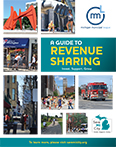Michigan’s cities and villages are the centers of our economy. They maintain the infrastructure and services that support the vast majority of our state’s jobs. A recent study found that Michigan’s metropolitan areas account for 89% of the state’s jobs and 88% of its gross domestic product.1 The revenue sharing distribution formula was designed to appropriately compensate the communities that support us all and the higher costs they bear. Therefore, when that formula is underfunded, Michigan’s entire economy suffers.
Revenue Sharing Keeps Our Economic Engines Running
A Michigan Municipal League survey found cuts in revenue sharing have negatively impacted basic community services across Michigan. Capital projects such as street and sidewalk repairs and sewer and water improvements have been postponed; recreation and library programs have been curtailed or eliminated. Perhaps even more startling is that, according to the Michigan Commission on Law Enforcement Standards, there are nearly 2,315 fewer police officers and 1,800 fewer firefighters on the streets of Michigan since the tragedy of September 11, 2001.2
 Formula Funding
Formula Funding
Revenue sharing consists of both constitutional and statutory payments. The constitutional portion consists of 15% of gross collections from the 4% sales tax3 distributed to cities, villages, and townships based on their population. This amount is set by the state constitution. The Legislature must appropriate whatever is calculated. It cannot reduce or increase the constitutional portion.
The statutory portion of revenue sharing has traditionally been distributed by a formula, rather than on a per capita basis, to compensate for the significant variation in local governments’ service delivery needs, infrastructure maintenance requirements, and fiscal capacity to generate local tax revenue. Today, the program calls for 21.3% of the 4% sales tax collections to be distributed in accordance with a formula set in Public Act 532 of 1998.
Since state law sets the statutory portion, the governor and Legislature have the ability to adjust the distributed amount. They have increasingly used this ability to cover state budget shortfalls to the detriment of communities, especially during the recent recession when local budgets are already strained by drops in property value. The 1998 formula was designed to be phased in, but due to funding cuts it has never been fully implemented. If fully funded, statutory revenue sharing payments to local governments, including counties, in fiscal year 2014 would have totaled approximately $1.8 billion. Instead, the state kept $689 million, appropriating $1.1 billion to communities. This shortfall is part of a trend totaling nearly $6.2 billion in revenue sharing reductions during the last twelve fiscal years.4
In 2011, the State added requirements for local governments to obtain their statutory revenue sharing payments. Entitled the Economic Vitality Incentive Program (EVIP), locals must now comply with three categories to receive payments. The categories include accountability and transparency, consolidation of services, and unfunded accrued liability plan.
History of Shared Revenue
Michigan cities, villages, and townships receive revenue earmarked by the state constitution and statute to help pay for core governmental services such as police protection, fire service, roads, water and sewer service, and garbage collection. Known as “revenue sharing,” these funds have been tied to restrictions on local taxes. In 1939, an early instance of revenue sharing occurred when a state law removed intangible property from the local property tax base. A state intangibles tax was created and a method put in place to return funds to locals to help with lost revenues. Since that time, additional state taxes such as the sales, income and single business tax have been enacted, while the levy of local taxes has been pre-empted or eliminated. This has been done with a pledge from state officials that a portion of revenues raised from state taxes would be returned to locals—shared—for the provision of essential services.
1Source: RW Ventures, “Michigan’s Metropolitan Areas Fact Sheet”
2Source: Michigan Commission on Law Enforcement Standards and Michigan Professional Firefighters Union
3The additional 2% sales tax created in 1994 is earmarked specifically for schools.
4Source: House Fiscal Agency
Additional information can be found in “The Great Revenue Sharing Heist” article.

 Formula Funding
Formula Funding